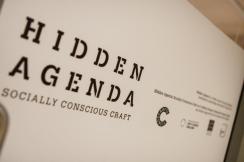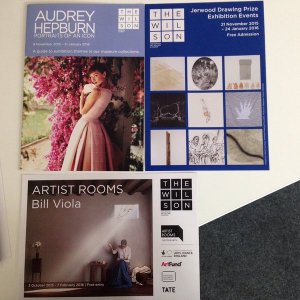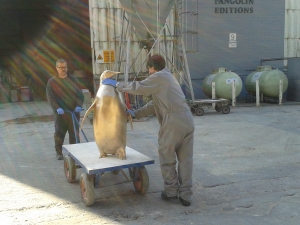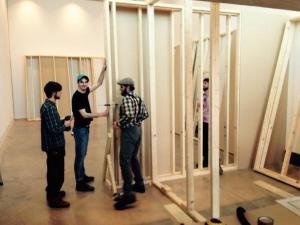Hidden Agenda: Socially Conscious Craft at The Wilson The Wilson has two new exhibitions currently open and running together – Hidden Agenda: Socially Conscious Craft and Crafting Change: Community, Protest, Utopia. In response to themes explored in the exhibitions, there are also four protest murals being displayed in the Chill Out space on the third floor, produced by the Wilson Art Collective, the LGBT Society University of Gloucestershire, Cheltenham’s Chinese community and Art Lift. In a series of blog posts I will be exploring each exhibition, starting here with Hidden Agenda: Socially Conscious Craft.
The Crafts Council touring exhibition Hidden Agenda: Socially Conscious Craft opened at The Wilson on the 5 March and runs until 5 June 2016. The exhibition is curated in partnership with Berwick Visual Arts and one of the contributing artists, Doug Jones. The work on display is all by makers and designers who use craft as a stage for social commentary and provocation; covering societal injustice, rebellion, propaganda, remembrance, monetary value and economy in materials and production methods. The exhibition wants to engage with people who already love craft or want to learn more about what craft means to society.
I want to talk about my favourite pieces within the exhibition starting with Angela O’Kelly’s work Hundreds and Thousands, her creation is a necklace made from circular cut-outs of the Financial Times newspaper and each piece has been methodically strung together to form the piece. The use of paper, a non-precious material, is meant to highlight the importance of workmanship and creativity over the mere value of materials.
The second piece I have chosen is Lois Walpole’s Apple Laundry Basket. Walpole’s laundry basket is made from Tesco apple juice cartons, which are then woven together using string and coiled willow. To create the lid Walpole layered card together, shaping it then an edging strip that was stitched on and the hole for the lid cut out. This was the first piece that Walpole produced using recycled and found material.
My final favourite piece from the exhibition is by Paul Scott; called A Willow For Ai Weiwei. The piece is an Earthenware platter (c.1840), which Scott bought on eBay. The ‘Willow’ pattern has been detailed with numerous sunflowers, and a silhouette of Ai Weiwei on a bridge. The work was made after Ai Weiwei was detained by Chinese police in 2011, and the silhouette could be seen to represent the Chinese government trying to silence Ai Weiwei’s creative voice, there are also small details of sunflower seeds on the back and front of the plate, which are an echo from his installation, Sunflower Seeds, part of The Unilever Series which was on display in the TATE modern in 2010.
Other artists’ whose works on display should not be missed include Grayson Perry, Lynn Setterington and Doug Jones (whose work, Generation, takes up the whole width of the gallery). A series of events is running alongside the exhibition, details and tickets for these can be found here.
Look out for my next two posts, about the partner exhibition Crafting Change: Community, Protest, Utopia, coming soon…













![[1] Detail of illustration by Edward Burne Jones from The Wood Beyond the World by William Morris, Kelmscott Press, 1894.](https://cheltenhamartgalleryandmuseum.files.wordpress.com/2015/11/picture-1-1991_1016_996_x47_001-detail-for-web.jpg?w=190&h=300)
![[2] Detail of illuminated initial by Charles Ricketts from The Book of Thel, Songs of Innocence and Songs of Experience by William Blake, Vale Press, 1897.](https://cheltenhamartgalleryandmuseum.files.wordpress.com/2015/11/picture-2-1991_1016_996_lb9_002-detail-for-web.jpg?w=205&h=206)
![[3] Detail of illustration by Walter Crane from The History of Reynard the Fox by FS Ellis, 1894.](https://cheltenhamartgalleryandmuseum.files.wordpress.com/2015/11/picture-3-1991_1016_996_a5_001-detail-for-web.jpg?w=213&h=300)
![[4] Detail of illustration by Lucien Pissaro from Songs by Ben Jonson, Eragny Press, 1906.](https://cheltenhamartgalleryandmuseum.files.wordpress.com/2015/11/picture-4-1991_1016_996_lf34_003-detail-for-web.jpg?w=296&h=300)
![[5] Illustration by Bernard Sleigh from The Sea King’s Daughter and Other Poems by Amy Mark, Birmingham Guild of Handicraft Ltd., 1895.](https://cheltenhamartgalleryandmuseum.files.wordpress.com/2015/11/picture-5-1986_1152_008-detail-for-web.jpg?w=211&h=300)








